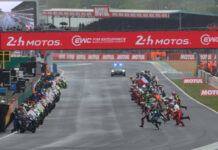FIRST PERSON/OPINION
By John Ulrich
Part Four
SPRO Henny Ray Abrams argues in the April 16 2008 issue of Cycle News (page 88) that the AMA “rulebook has to be black and white, but the AMA likes gray so they can muddy the waters by asking their sleuths to debate the psyches and subtleties of engine builders.” He is outraged by the fact that “the rulebook specifies two kinds of penalties, which the AMA can impose at its discretion. Category 1 is for violations ‘that could potentially or effectively enhance the performance of a motorcycle used in competition.’ Category 2 is ‘all other equipment violations.'”
SPRO Abrams is further outraged that Josh Hayes was disqualified from the 2008 Daytona 200 because his Formula Xtreme-class Erion Honda CBR600RR ran a crankshaft that had been significantly modified to increase horsepower; that modification fell under Category 1 of the AMA rules. But Abrams, and by extension Cycle News Editor Paul Carruthers, being the technical wizards that they are, are also outraged that Martin Cardenas was not disqualified from the 2008 Daytona 200 because his Formula Xtreme-class M4 EMGO Suzuki GSX-R600 ran a crankshaft that had been insignificantly modified in a way that did not increase horsepower and thus fell under Category 2 of the AMA rules. (Please note that Carruthers has specifically told me that he is not responsible for or involved in this or any other argument presented by SPRO Abrams on the pages of the publication Carruthers has edited for, I’m guessing here, maybe 20 years straight. I must admit that I sometimes wonder if Carruthers even reads the magazine that claims him as Editor.)
Hence SPRO Abrams’ pronouncement that all rules violations, no matter how trivial, should result in the death penalty, black and white, no questions asked.
That is an argument only somebody who hasn’t been paying attention, isn’t really involved in motorcycle racing, or is working an angle (or is paid to work an angle) would embrace. We’ve been down that road, and it wasn’t a good thing.
There are two ways to look at motorcycle road racing rules. One is a literal interpretation of the wording, and the other is to consider the wording within the context of the rule’s intent and whether or not any given violation produces a competitive advantage.
In the 1970s the AFM rulebook required that Production-class machines run stock bodywork, and had only one applicable penalty: Disqualification. One rider took working the rulebook to a fine art, routinely protesting his way forward in the results. The type of violations that got riders thrown out and allowed the protest king to accomplish in tech inspection what he couldn’t do on the racetrack? In two examples, a missing RD350 Yamaha front fender stay, which a rider hadn’t replaced when it was bent in a crash, and the lack of a chain guard.
During the same time period, a burned-out headlight bulb could get a rider disqualified from certain WERA classes even when the races were run in broad daylight, and it became common for riders to anonymously protest their way forward in the results after getting beaten on track. In the mid 1980s, an Australian arrived in the U.S., bought a salvage-yard GSX-R750, pieced it back together without even touching the engine and showed up at Roebling Road Raceway for a contingency-paying WERA race. He made it onto the box but was disqualified when a competitor protested his bike’s lack of a complete rear fender. Watching the race, it sure didn’t look to me like his finishing position had anything to do with that partially intact rear fender.
The DQs were based on a literal interpretation of the rules, and every infraction resulted in the death penalty. It was a strange way to run a sport.
In the late 1970s, I got together with Whitney Blakeslee and Lee Fleming, two guys I raced against in AFM events, and we all volunteered to be on the AFM Rules Committee for the following year. As it turned out, nobody else volunteered and we discussed and re-wrote the entire AFM rulebook line by line. When we were done, there were two types of rule violations listed in the book, performance violations and non-performance violations. In the case of performance violations, stuff that made a difference on the racetrack, the penalty was still disqualification. But in the case of non-performance violations, the penalty became a nominal fine.
The AFM Board accepted and approved the rewritten rulebook, but when we showed up at Riverside Raceway for the first race of the new year, the guy who had made a habit of protesting his way onto the box (after on-track finishes as far back as 14th) filed his usual paperwork with tech and waited for his finish to be artificially improved. The tech inspectors on duty, who had not bothered to read the new rulebook, dutifully started disqualifying riders for largely cosmetic violations until an aggrieved rider confronted Lee, Whitney and I and demanded to know why we had told him that the rules had been improved when he was facing the same old sh-t in tech. I headed down to tech with a copy of the new rulebook in hand, and after a brief discussion the AFM Race Director overruled the DQs and we all went about the business of determining who won on the racetrack, fairly.
Based on that experience and seeing the same kind of crap at WERA events in the late 1980s, I volunteered to tune up the WERA rulebook. Again, the resulting language listed two types of violations, performance and non-performance, and two types of penalties, the traditional disqualification for violations that affected on-track performance, and nominal fines for violations that did not affect on-track performance. The rulebook also stated that its purpose was to ensure fair competition on the racetrack, NOT to allow riders (or teams) to use the rules to accomplish what they couldn’t get done on the track. Anonymous protests were no longer allowed, and the Race Director and the President of WERA specifically had the option of dismissing frivolous protests over technicalities that did not affect the on-track competition.
Almost a decade ago, I volunteered to re-write the AMA Pro Road Racing rulebook line-by-line. Tell me what you are trying to accomplish with each rule, I told AMA officials, and I will give you a piece of language that can only be interpreted one way, with no gray areas. Move stuff that doesn’t really count on the racetrack into the category of non-performance violations, and mandate nominal fines instead of automatic disqualification.
AMA Pro Racing’s Merrill Vanderslice and Ron Barrick were not interested in having me anywhere near their rulebook. Apparently, they thought that I would insert trick language that would benefit my race team later. Actually, I WOULD have gained an advantage if they had taken me up on my offer, because I (along with everybody else in the paddock) would have been able to understand exactly what each rule was trying to accomplish and what it actually meant, instead of having to deal with their shifting interpretations and capricious enforcement.
They turned me down, and Vanderslice went on to make several decisions based on bizarre interpretations of the rules–evidently he couldn’t always remember the original intent of language he wrote or approved. In the most infamous decision of that type Vanderslice told Erik Buell that melting down and recasting a V-Twin’s crankcases (as if that would actually happen, as opposed to simply casting up new cases!) was legal, because a rule said that engine modifications were unlimited for air-cooled Twins. So Buell built and sold an XBRR racebike that featured completely different crankcases than the cases used for the Buell streetbike on which the racebike was theoretically based, and never mind that the intent of the Formula Xtreme class was that machines be based on production motorcycles. Vanderslice decided that the word “modified” allowed casting up a new part with different bore centers and overall construction.
But one thing that Merrill and company did do, was create Category 1 and Category 2. Break a rule and do something that fit under Category 1, that improved on-track performance, and the death penalty still applied. Break a rule and do something that fit under Category 2, and did not improve on-track performance, and the death penalty did not apply.
SPRO Henny Ray Abrams disagrees with this type of rules differentiation, for obvious political reasons already discussed in this series. Paul Carruthers doesn’t know any better. And the result is a call for all death, all the time. They may as well be railing against the use of antibiotics on religious grounds, or advocating a return to The Dark Ages complete with The Black Death.
People who were there, know better.
To be continued”¦






